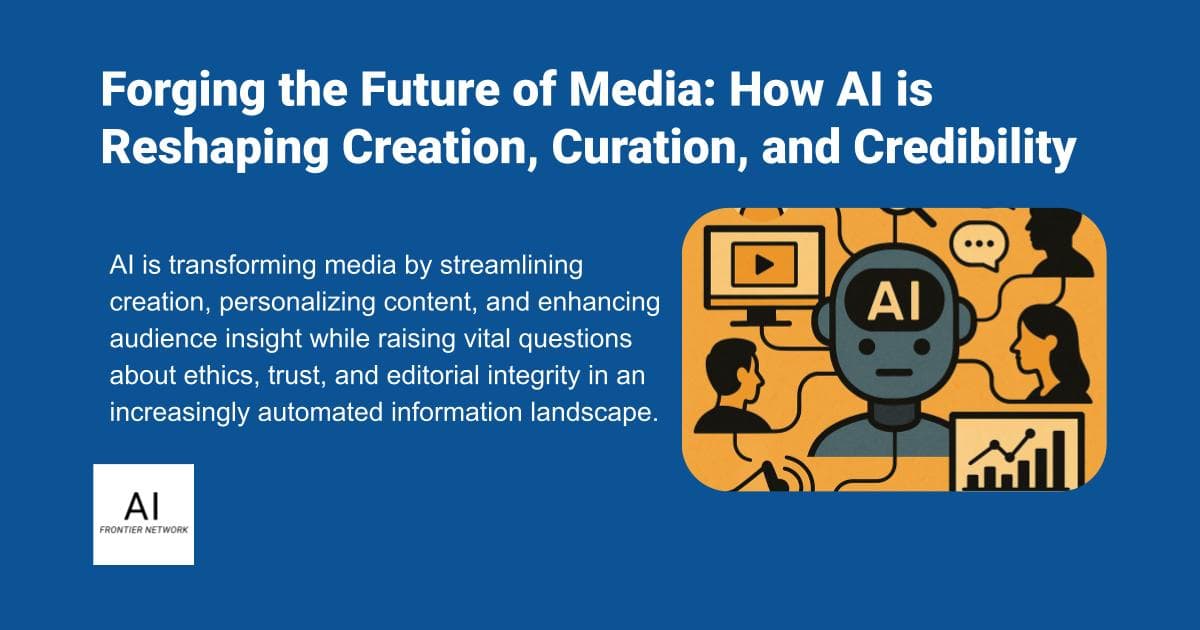From newsroom algorithms to personalized entertainment streams, AI is rapidly transforming how media is made, distributed, and consumed. It’s not just a new tool—it’s a new framework for storytelling, audience engagement, and operational efficiency. But as media moves faster, becomes more responsive, and scales with automation, a central question persists: how do we preserve truth, trust, and creativity?
We gathered insights from engineers, journalists, strategists, and executives at the forefront of AI and media. Here’s what they’re seeing—and shaping.
AI Is Scaling Media Creation and Personalization
Across newsrooms, studios, and social platforms, AI is helping media teams do more with less. As Shailja Gupta puts it, AI is now foundational, from automating tasks to personalizing content in news, entertainment, and advertising. On platforms like Meta and X (formerly Twitter), it powers everything from content moderation to real-time search via tools like Grok.
Ganesh Kumar Suresh expands on this: AI isn’t just saving time, it’s unlocking new creative and commercial possibilities. It drafts copy, edits videos, suggests scripts, and analyzes distribution—all in real time. “This isn’t about replacing creativity,” he writes. “It’s about scaling it with precision.”
That precision shows up in marketing, too. Paras Doshi sees AI enabling true 1:1 communication between brands and audiences—adaptive, dynamic, and context-aware storytelling. Preetham Kaukuntla adds a word of caution: “It’s powerful, but we have to be thoughtful… the goal should be to use AI to support great storytelling, not replace it.”
The New Editorial Mandate: Verify, Label, and Explain
Automation doesn’t absolve responsibility—it increases it. As AI writes, edits, and filters more content, maintaining editorial integrity becomes a first principle. Dmytro Verner underscores the need for transparent labeling of AI-generated content and the evolution of the editor’s role into one of active verification.
Rajesh Sura echoes this tension: “What we gain in speed and scalability, we risk losing in editorial nuance.” Tools like ChatGPT and Sora are co-writing media, but who decides what’s “truth” when headlines are machine-generated? He advocates for AI-human collaboration, not replacement.
This sentiment is reinforced by Srinivas Chippagiri and Gayatri Tavva, who argue for clear ethical guidelines, editorial oversight, and human-centered design in AI systems. Trust, they agree, is the bedrock of credible media—and must be actively protected.
From Consumer Insight to Content Strategy
AI doesn’t just help create—it helps listen. Anil Pantangi sees media teams using predictive analytics and sentiment analysis to adapt content in real time. The line between creator and audience is blurring, and smart systems are guiding that shift.
Sathyan Munirathinam points to companies like Netflix, Spotify, and Bloomberg already using AI to match content with user preferences and speed up production. On YouTube, tools like TubeBuddy and vidIQ help optimize content strategy based on performance data.
Balakrishna Sudabathula highlights how AI parses trends from social media and streaming metrics to inform what gets made—and how it’s distributed. But again, he emphasizes, “Maintaining human oversight is essential… transparency builds trust.”
The Ethical Frontier: Can We Still Tell What’s Real?
As AI-generated content floods every format and feed, we’re entering an era where the signal and the noise may come from the same model. Ram Kumar N. puts it bluntly: “We’re not just automating headlines—we’re scaling synthetic content, synthetic data, and sometimes synthetic trust.”
For him, human judgment becomes the filter, not the fallback. The editorial layer—ethics, nuance, intent—must lead, or risk being left behind. Dr. Anuradha Rao offers a path forward: collaborative tools, clear accountability, and regulatory frameworks that prioritize creativity and inclusion.
Nivedan S. adds that AI is fundamentally a mirror: it reflects what we prioritize in its design and deployment. “We must build with transparency, accountability, and editorial integrity, or we risk eroding the very foundation of trust.”
The Future: Human-Centered Media, Powered by AI
What’s clear from all voices: the future of media won’t be AI vs. humans—it will be humans amplified by AI. Tools can create faster, analyze deeper, and personalize at scale. But values, truth, empathy, and creativity remain human responsibilities.
This future belongs to those who can navigate both algorithms and ethics. To those who can blend insight with intuition. And to those who recognize that in an AI-powered media world, trust is the most important story we can tell.















